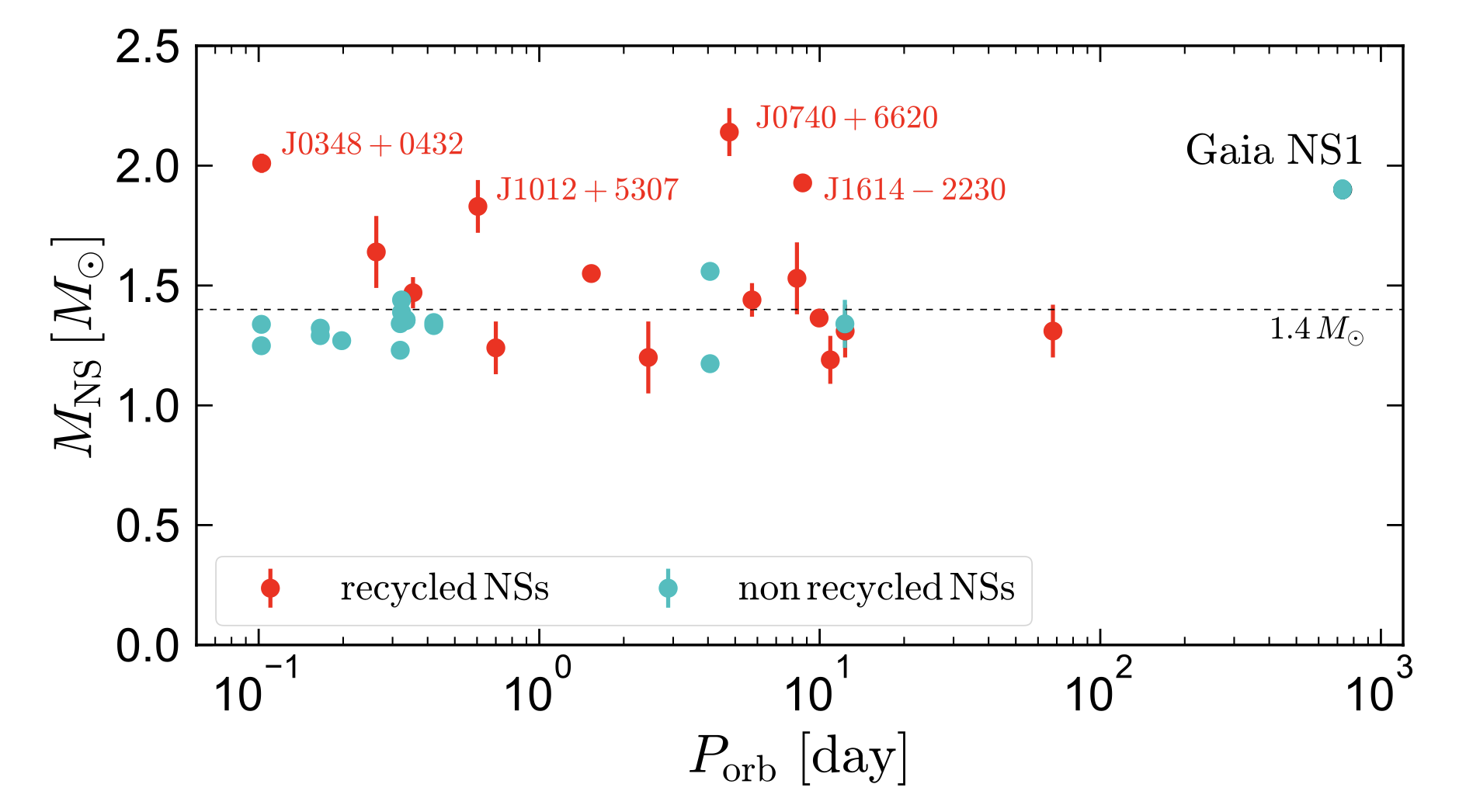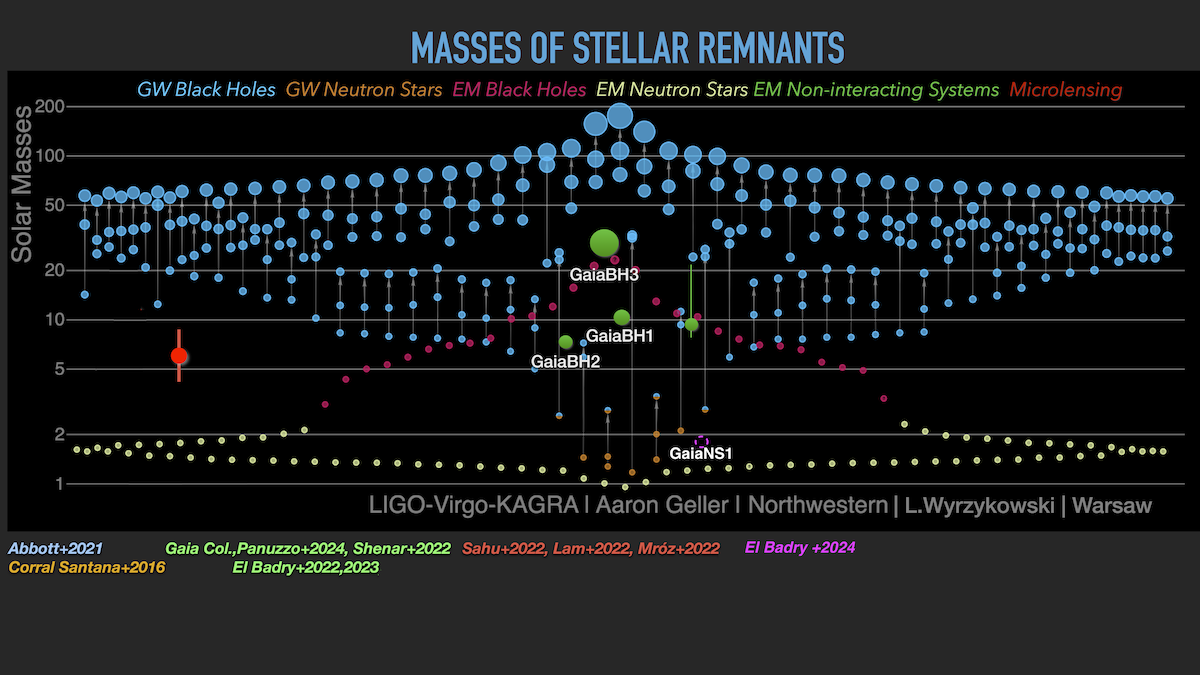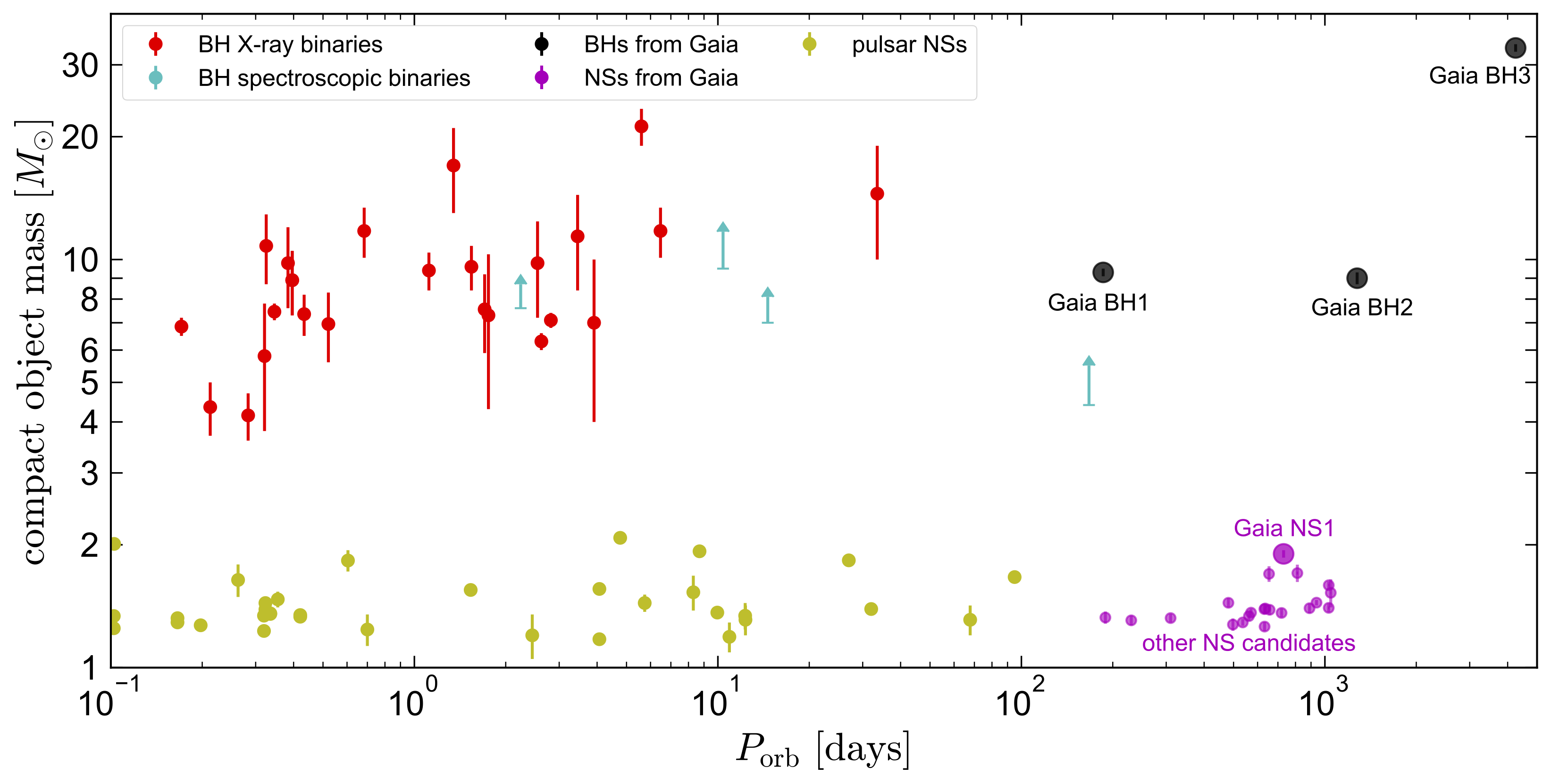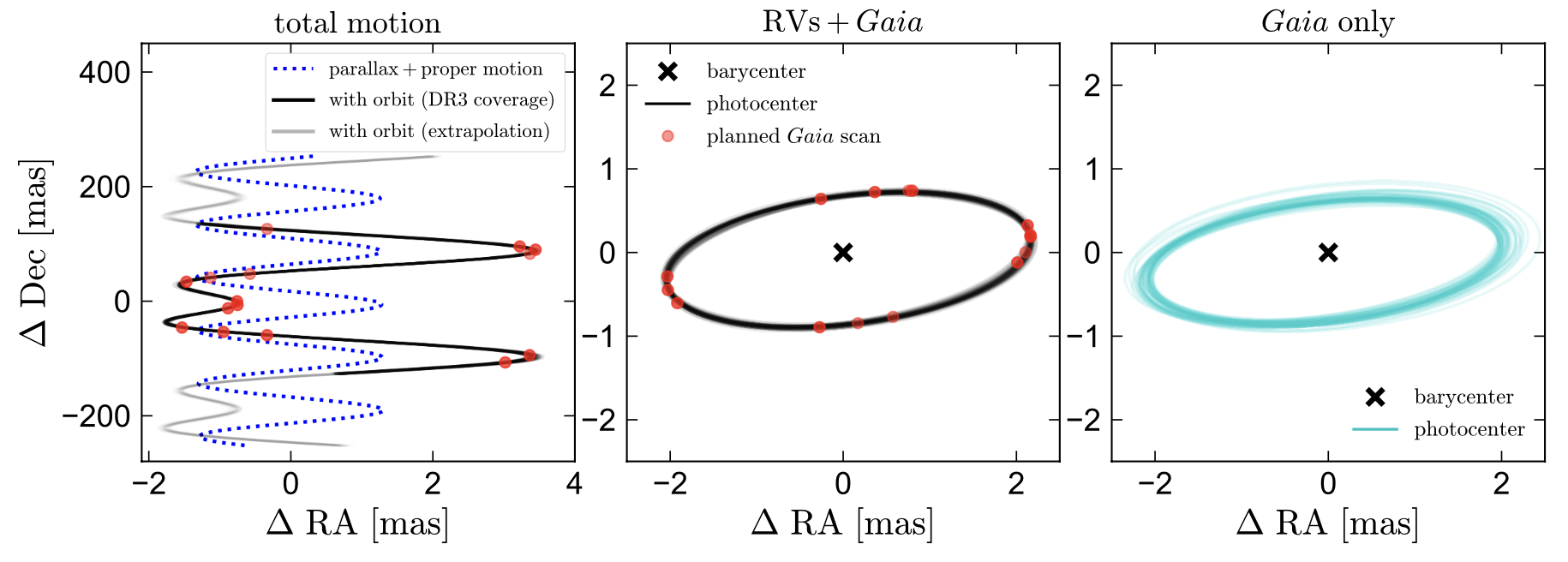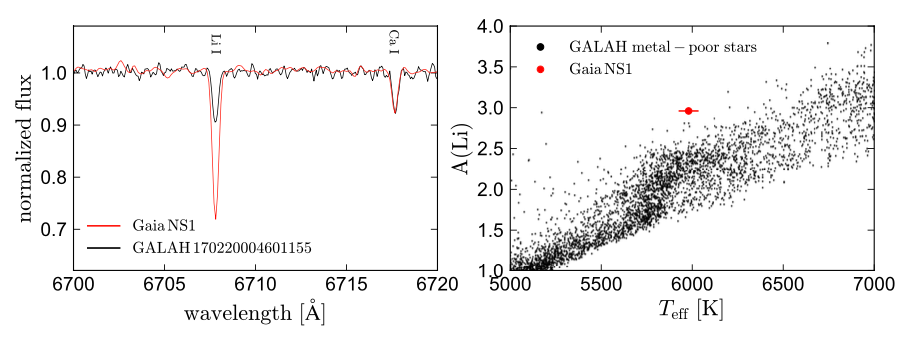IoW_20240528 - Gaia
Image of the Week
Did Gaia find its first neutron star?
Figure 1. Overview of known neutron stars, showing both recycled and non-recycled neutron stars. The colour red refers to recycled neutron stars, these are neutron stars that have accreted material after birth. The colour cyan refers to non-recycled neutron stars and this group consists mainly of double neutron star binaries with a few neutron star + massive white dwarf binaries. Gaia's potential first neutron star, Gaia NS1, clearly stands out with a high mass and a large period. Credits: Figure 11 of Kareem El-Badry, et al. 2024.
With the publication of Gaia’s non-single star catalogue, a massive follow-up started of potentially interesting cases. Scientists were especially eager to follow up on candidate dark companions like black holes and neutron stars.
Kareem El-Badry and other scientists across the world scheduled high-resolution spectroscopic follow-up of interesting candidates with dedicated observatories like Keck, Magellan, La Silla, and Whipple. While many follow-up campaigns are still ongoing, the first discoveries were published and led to the finding of two black holes: Gaia BH1 and Gaia BH2. A third black hole, Gaia BH3, was recently announced based on pre-release data from Gaia DR4. Now, also Gaia’s potential first neutron star is found, dubbed Gaia NS1.
Figure 2. Overview of black holes found by gravitational-wave observatories in distant galaxies complemented with the black holes found closer to home in our Milky Way through electromagnetic radiation. Since recently, this overview contains new entries found in a different way, through astrometry! Shown in green are the electromagnetically non-interacting systems, also known as dormant black holes. Newest addition can be found in pink: Gaia NS1. The Gaia mission plays an important role in finding new systems through astrometry. The original plot was adapted by several groups, and the additions show up as circles with different colours. These circles have a size that is not on the same scale as the original plot created for the LIGO-VIRGO-KAGRA results. Credits: Adapted from LIGO-VIRGO-KAGRA, Aaron Geller, Northwestern / L. Wyrzykowski, Warsaw by ESA/Gaia/DPAC.
Gaia NS1 is the dark companion that is part of a binary system with a luminous, low-metallicity star near the main-sequence turnoff. The dark companion has a mass of ~1.9 solar masses which is massive enough to be outside the white dwarf range but also a low enough mass to point to a neutron star rather than a black hole.
Since Gaia’s data releases, thousands of white dwarfs in astrometric and spectroscopic binaries were found. White dwarfs are the stellar cores left behind after a star died. They are no longer fueled by nuclear reactions and have expelled their outer layers. Typically, white dwarfs have masses ranging from 0.17 to 1.33 solar masses. It is believed that no stable white dwarfs can exist beyond a mass of ~1.4 solar masses, a limit referred to as the Chandrasekhar limit.
Neutron stars are much more massive than white dwarfs and are formed from the collapse of massive supergiant stars. They are also denser than any other stellar object, except for black holes. Gaia NS1 with its 1.9 solar masses places well beyond the Chandrasekhar limit, its full mass contained within a sphere of ~10 km radius.
Figure 3. Overview of known stellar mass black holes and neutron stars (excluding results found in distant galaxies through gravitational-wave observatories). To allow both black hole and neutron star populations to be shown in the same plot, please note the non-linear axes on the left. From this plot it is clear that the new additions found by Gaia all have wider orbits with larger orbital periods. Credits: Kareem El-Badry - CC BY-SA 3.0 IGO.
At first, Gaia NS1 was thought to be a black hole candidate. From Gaia data alone, the computed mass for the dark companion was found in the range of 2.2 to 4.3 solar masses, which points to a low-mass black hole of stellar origin. But these results assumed that the companion star was metal-rich, like the Sun.
The high-resolution spectroscopic follow-up uncovered that the companion star is actually metal-poor. It is a main-sequence star formed more than 12 billion years ago and belonging to the halo. Located near the main-sequence turnoff, it has already started to inflate and is expected to become a red giant in less than a billion years.
The fact that the companion star is metal-poor changes the estimate for the mass of this star quite significantly, from an assumed 1 to 1.4 solar masses to an estimated 0.8 solar masses. The mass of the dark companion is derived from the astrometric orbit as measured by Gaia, and if the bright companion’s mass changes significantly, this influences the derived mass of the dark companion, dropping it severely and moving it firmly into the neutron star range at 1.9 +/- 0.04 solar masses.
One might wonder if this dark companion couldn’t perhaps be a very low-mass black hole. So far there has not been evidence for such low mass black holes yet, but it cannot be excluded. It would be more likely though that the dark companion consists of a combination of two massive white dwarfs in a close binary themselves. With current stellar evolution models however, there is no evidence pointing to the creation of such a system. Leaving the simplest explanation: the dark companion is probably a neutron star.
Figure 4. The black lines show the best-fit orbit using both Gaia DR3 data and the Radial Velocity data from follow-up observations. Predicted observations times of Gaia NS1 photocentre by Gaia using the Gaia Observation Forecast Tool are shown in red. The predicted scan times show that the orbit is well sampled. Credits: Figure 4 of Kareem El-Badry, et al. 2024.
There is more to this discovery. The binary system has an orbital period of 731 days, with a low eccentricity orbit, making it almost circular. The eccentricity is so low that the dark companion is most likely formed with little mass loss and only a weak natal kick. A stronger natal kick would have increased the eccentricity of the orbit or even destroyed the binary system, while another formation scenario is very unlikely due to the tight orbit of the system. It makes Gaia NS1 the most massive neutron star formed without accretion.
But Gaia NS1 does not stand on its own. As seen already in Figure 3, many other candidates exist. A set of 21 astrometric binaries containing solar-type stars and dark companions with masses of about 1.4 solar masses are being followed-up. For several of them the luminous component seems to be a metal-poor star, and all of these metal-poor stars seems to be strongly enhanced in lithium, as is also the case for the luminous component of Gaia NS1.
Figure 5. On the left: Observed spectrum of the luminous component of Gaia NS1 (red) as compared to a reference star from the GALAH survey with a spectrum that best matches the one for Gaia NS1 system. On the right: Gaia NS1 is clearly an outlier in lithium abundance and has a higher Lithium value than any similar star from the GALAH survey. Credits: Figure 6 from Kareem El-Badry et al., 2024.
This observational evidence, along with the earlier findings on Gaia’s black holes, again challenges current binary evolution models. Lots of work remains for astronomers to improve these models and make them match Gaia’s observations of the exotic systems in our Milky Way. Gaia’s next data releases promise to bring a wealth of new dark companions to be studied, expanding on both mass ranges and binary periods. While most of the dark companions found with Gaia data are relatively close to Earth, with a longer time span of observations, the discovery space will expand further out into the Milky Way.
This animation shows the orbits of the luminous star and the neutron star around their common centre of mass. The red dots shown are the expected locations of Gaia observations of the luminous star as obtained with the Gaia Observation Forecast Tool. It is clear that there can be many different angles at which such systems are observed. Gaia NS1 is depicted in the bottom left. Credits: Kareem El-Badry - CC BY-SA 3.0 IGO.
Further reading:
- Paper: "A 1.9 Solar mass neutron star candidate in a 2-year orbit" by Kareem El-Badry, et al. 2024
- Paper: "A population of neutron star candidates in wide orbits from Gaia astrometry" by Kareem El-Badry, et al. 2024 (preprint)
- Story: Gaia's first black hole discovery: Gaia BH1
- Story: Gaia discovers a new family of black holes
- Story: Gaia spots Milky Way's most massive black hole of stellar origin
- Story: Sleeping giant surprises scientists
- Story: Gaia Data Release 3: is it a double star?
Story written by T.Roegiers.
Credits: ESA/Gaia/DPAC, Kareem El-Badry
[Published: 24/05/2024]
- Removed a total of (19) style text-align:center;
- Removed a total of (27) style text-align:justify;
- Removed a total of (1) style margin:0;
Image of the Week Archive
- Removed a total of (1) border attribute.
- Removed a total of (1) cellpadding attribute.
- Removed a total of (1) cellspacing attribute.








































 Sign in
Sign in
 Science & Technology
Science & Technology
